Maritime passenger statistics
Data extracted in November 2023.
Planned update: 29 November 2024.
Highlights
Seaborne passengers embarked and disembarked in all ports, EU, 2007-2022
This article presents the latest statistical data on passenger traffic in ports in the European Union (EU), the EFTA countries Iceland and Norway and the candidate countries Montenegro and Türkiye. It also covers maritime transport flows with the main partner geographical areas, as well as individual results for major European ports. This article contains data for 2022.
Full article
Number of seaborne passengers only partially recovered in 2022, after the effects of the COVID-19 pandemic
After falling regularly between 2008 and 2014, with an exception in 2013 (+0.3 % compared with 2012), the total number of passengers embarked and disembarked in EU ports recovered in the last five years to reach a peak in 2019 with 418 million (+2.2 % in 2019 compared with 2008, year of the previous peak). As the result of strict precautionary measures taken because of the COVID-19 pandemic, maritime passenger transport almost halved in 2020 compared with 2019 (-45.0 %). The number of passengers passing through EU ports reached a low point of 230 million in 2020 (Figure 1). In 2021 and 2022, a partial recovery was recorded with successive increases by 16.4 % and 30.1 % compared with 2020 and 2021, respectively. In 2022, 348.6 million passengers were recorded in EU ports, which was still way below the levels observed before the pandemic. Compared with 2019, the number of passengers in EU ports decreased by 16.7 % in 2022. The first quarter of 2021 was still largely impacted by the precautionary measures taken because of the COVID-19 pandemic, showing a decrease by 47.5 % compared with the 1st quarter of 2020. The three other quarters of 2021 and all quarters of 2022 registered substantial increases when comparing with the same quarters of previous year. The largest increases were recorded in the second quarter of 2021 (+53.9 %), and in the first and second quarters of 2022 (+61.7 % and +67.7 %, respectively.
Unlike movements of goods, where broadly 60 % of goods are unloaded and 40 % loaded in EU ports, the difference between the number of passengers disembarking ('inwards') and embarking ('outwards') in EU ports is generally small. This reflects the fact that seaborne passenger transport in Europe is mainly carried by national or intra-EU ferry services, with the same passengers being counted twice in the port throughput statistics (once when they embark the ferry in one EU port and once when they disembark the same ferry in another EU port).
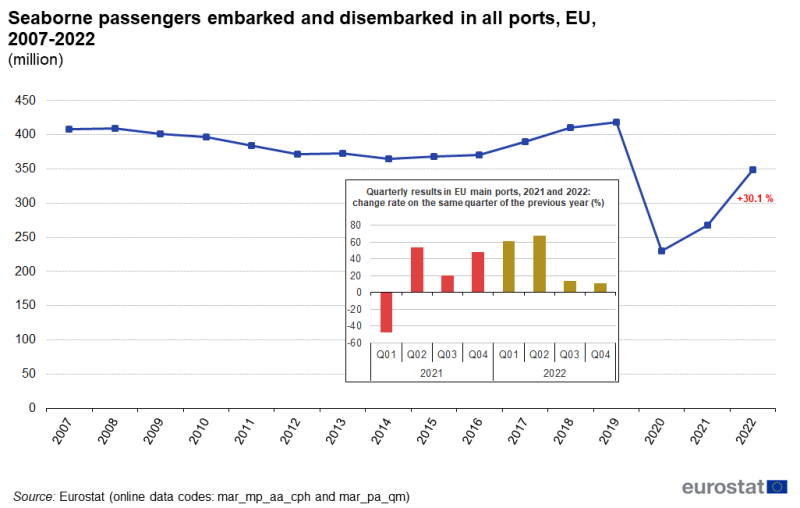
(million)
Source: Eurostat (mar_mp_aa_cph) and Eurostat (mar_pa_qm)
At 70.1 million seaborne passengers, Greek ports accounted for 20 % of the total number of passengers embarked and disembarked in EU ports in 2022 (Figure 2). When adding up the number of passengers embarked and disembarked in Greek ports together with those in Italian and Danish ports (53.8 million and 41.2 million, respectively), the combined share represented almost half (47 %) of the passengers embarked and disembarked in EU ports in 2022. These three countries were followed by Croatia with 33.0 million passengers embarked and disembarked in 2022, Spain (31.3 million), Germany (27.7 million), Sweden (24.9 million), France (19.0 million), Finland (13.6 million), Malta (12.6 million) and Estonia (11.7 million).
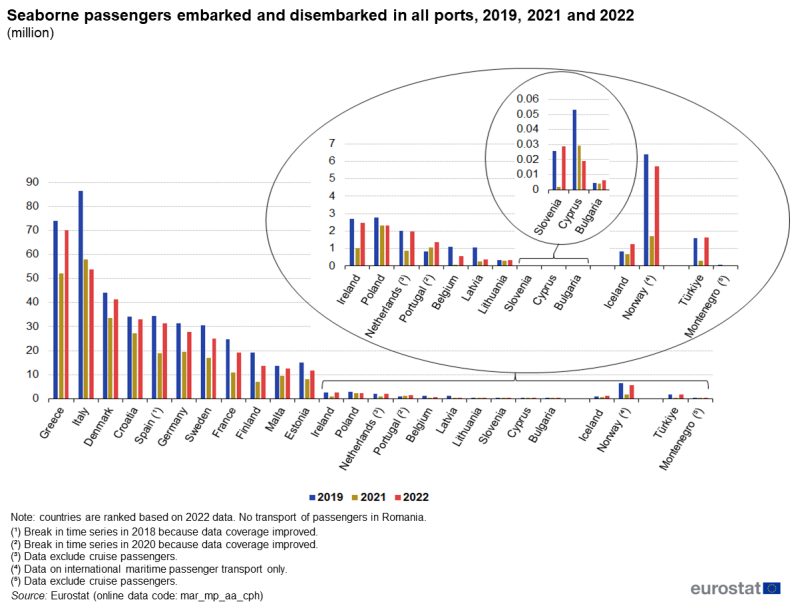
(million)
Source: Eurostat (mar_mp_aa_cph)
In 2022, all EU Member States, with the exception of Bulgaria and Slovenia, were still impacted by the pandemic related restrictions put in place in the EU and worldwide. Bulgaria and Slovenia increased by 37.2 % and 12.2 % between 2019 and 2022, respectively. The EFTA country Iceland also registered an increase by 49.6 %, while the candidate country Türkiye reached similar levels as in 2019 (+0.6 % between 2019 and 2022). Compared with 2019, the remaining EU Member States, the EFTA country Norway, as well as the candidate country Montenegro registered falls in the number of passengers passing through their ports. The largest relative decreases in seaborne passenger transport were recorded by Latvia and Cyprus (-65.4 % and -64.5 %, respectively). The candidate country Montenegro also decreased by 87.2 %, with 11 000 passengers in 2022. Belgium and Italy were other countries recording substantial falls by 47.8 % and 37.8 % in 2022 compared with 2019. Among the remaining EU Member States, three recorded a decrease between 20 % and 30 % over the same period, while three other EU Member States and the EFTA country Norway registered a drop between 10 % and 20 %. It has to be noted that from 2020, data for Portugal includes additional ports for which data was not available in previous years. Therefore, 2022 data are not comparable with 2019. By excluding data for the additional ports in 2022, Portugal registered a decrease by 5.5 % in 2022 compared with 2019. When comparing 2022 with 2021, two EU Member States recorded a decrease: Cyprus (-35.0 %) and Italy (-7.0 %). By contrast, Slovenia and Belgium recorded the highest growths over the same period. The number of passengers was multiplied by 15 in Slovenia (from 2 000 to 29 000 passengers) and by more than 6 in Belgium (from 88 000 to 570 000 passengers). The candidate country Türkiye also increased substantially from 289 000 passengers in 2021 to 1.62 million in 2022. Ireland and the Netherlands, as well as the candidate country Montenegro, more than doubled the number of passengers embarked and disembarked in their ports, while the EFTA country Norway more than trebled. Among the remaining EU Member States, Finland almost doubled while 12 member States recorded a growth of between 20 % and 75 % over the same period. Iceland also registered a growth by 77.1 % from 2021 to 2022. The increases were more moderate for Lithuania (+8.1 %) and Poland (+0.8 %).
Number of seaborne cruise passengers, with 10.0 million in 2022, are still below the 2019 levels
The number of cruise passengers passing through EU ports plummeted to 1.2 million in 2020 and rebounded in 2021 and 2022 to 2.8 and 10.0 million, respectively. Even if numbers have been almost multiplied by four between 2021 and 2022, this is still below the levels of 2019, when 14.6 million cruise passengers passed through EU ports (Table 1). Although cruise passengers represent only a small share of the total number of passengers embarked and disembarked in EU ports, these passengers play an important role in the ports and countries where the cruise traffic is concentrated. Almost 74 % of the total number of cruise passengers embarked and disembarked in EU ports in 2022 did so in the ports of one of the three countries Italy (2.7 million cruise passengers; or 27.1 % of the EU), Spain (2.6 million cruise passengers; or 26.4 %) and Germany (2.0 million cruise passengers; or 20.0 %). Cruise passengers on day excursions in EU ports are not included in these figures.
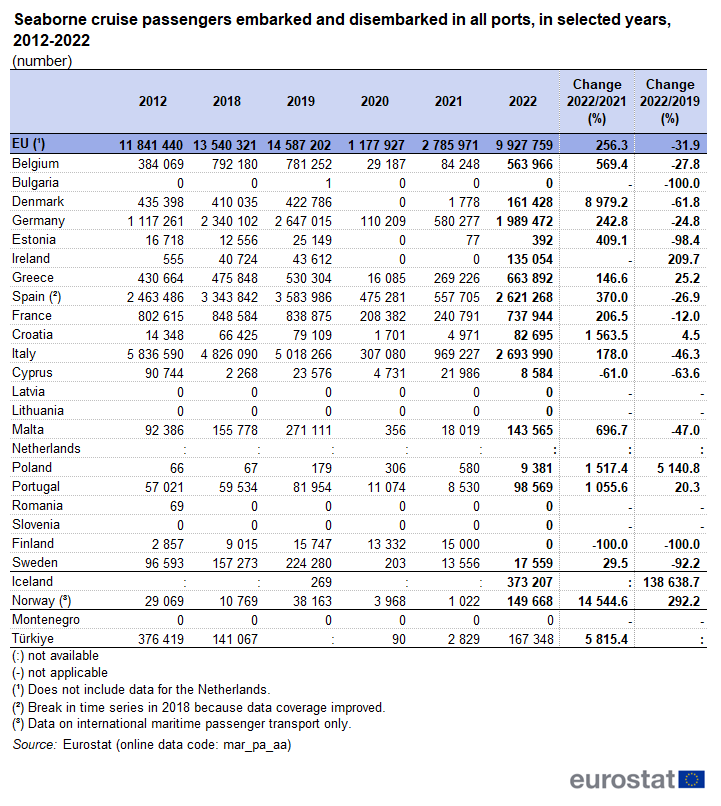
(number)
Source: Eurostat (mar_pa_aa)
Only five countries recorded an increase in 2022 compared with 2019: Poland (from less than 200 in 2019 to 9 000 cruise passengers in 2022), Ireland (from 44 000 in 2019 to 135 000 cruise passengers in 2022), Greece (+25.2 %), Portugal (+20.3 %) and Croatia (+4.5 %). Finland did not report any cruise passengers in 2022 while 16 000 were reported in 2019. Besides Finland, Estonia and Sweden recorded the highest falls in 2022 compared with 2019 (-98.4 % and 92.2 %, respectively). Among the remaining EU Member States, four decreased by more than 45 % over the same period. For four other EU Member States, the drop was between 10 % and 30 %. When comparing with 2021, cruise passengers substantially increased in 2022 in all EU Member States except in Finland, where no cruise passengers were reported while 15 000 were reported in 2021, and in Cyprus (-61.0 % between 2021 and 2022).
Messina remained the largest EU passenger port in 2022
The top 20 passenger ports accounted for 37 % of the total number of passengers embarked and disembarked in the reporting countries in 2022. The port of Messina remained the largest EU passenger port in 2022, with 9.4 million passengers (Figure 3). All ports of the top 20 decreased substantially in 2022 compared with 2019, with the exception of the two Greek ports Paloukia Salaminas and Perama (both +2.2 %). Amongst the top 20 ports in 2022, Napoli (-41.1 %), Calais (-39.3 %), Helsinki (-31.5 %), Tallinn (-31.3 %) and Algeciras (-28.1 %) recorded the highest falls in 2022 compared with 2019, dropping seven, nine, two, five and six positions in the ranking, respectively. Among the remaining ports, eight ports recorded a drop between 10 % and 20 % over the same period. The port of Santa Cruz de Tenerife recorded the lowest drop by 0.8 %. When comparing with 2021, all ports recorded substantial increases in 2022. The highest growth was registered by Algeciras (+230.7 %), followed by Calais (+115.4 %) and Helsinki (+112.8 %). Among the remaining ports, six ports recorded a growth between 55 % and 85 % over the same period, while nine recorded an increase between 15 % and 40 %. Lastly, Messina increased by 14.1 % and Reggio Di Calabria by 9.0 %. Compared with 2021, four ports entered the top 20: Burgstaaken/Fehmarn, Rødby (Færgehavn), Calais and Algeciras replacing Sjællands Odde, Århus, Piombino and Isola d’Elba. It should be noted that the composition of the top 20 ports in 2022 was the same as in 2019, even though the ranking was different.
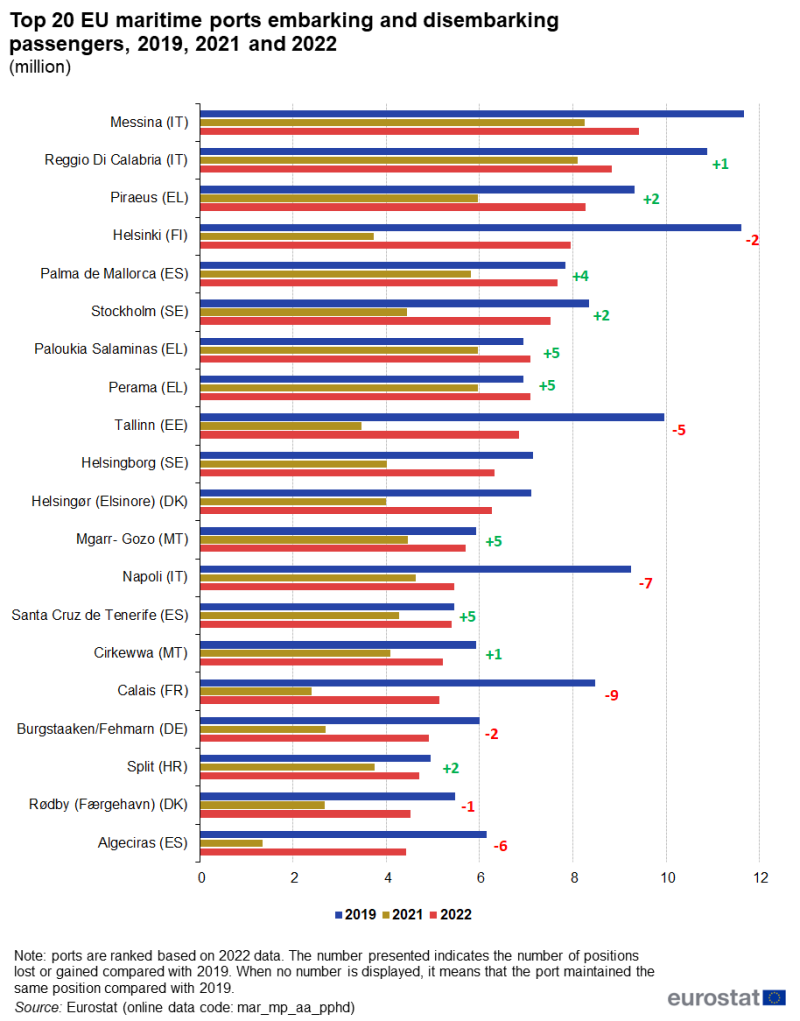
(million)
Source: Eurostat (mar_mp_aa_pphd)
Most EU seaborne passenger transport is within national borders
Table 2 and Figure 4 show the breakdown of seaborne passenger transport (excluding cruise passengers) between national, international intra-EU and international extra-EU transport for each reporting country. Unlike the other statistics presented in this article, these figures do not reflect the sum of embarkation and disembarkation of passengers in ports, but estimate the transport of passengers between ports. As far as possible, double-counting of the same passengers being reported as embarked in one port and disembarked in another port within the same statistical aggregate is excluded in these figures (see data sources).
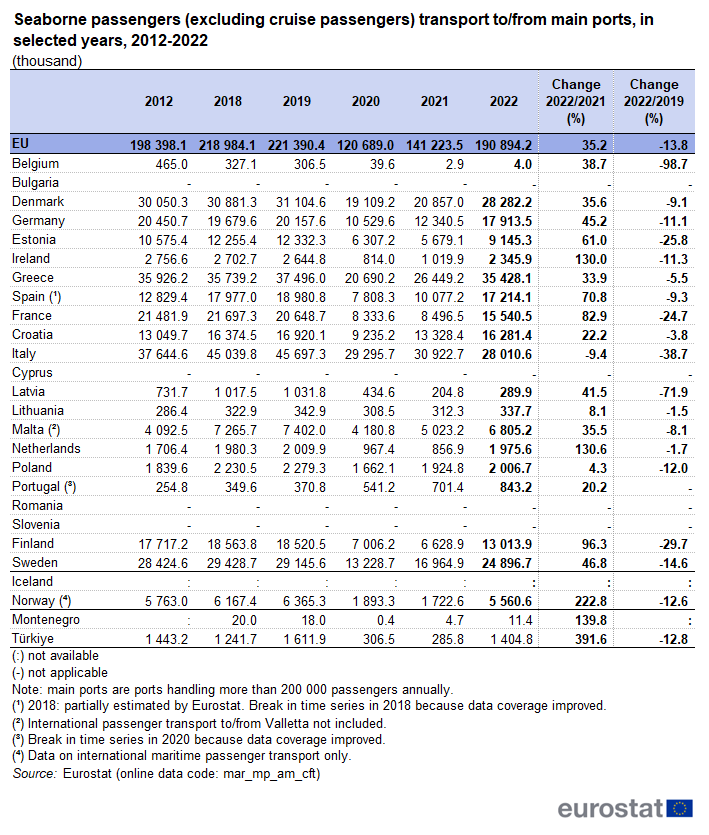
(thousand)
Source: Eurostat (mar_mp_am_cft)
At 191 million, the EU seaborne transport of passengers (excluding cruise passengers) increased by 35.2 % between 2021 and 2022, but decreased by 13.8 % between 2019 and 2022 (Table 1). Compared with 2019, all EU Member States recorded decreases in 2022: the most noticeable being for Belgium (-98.7 %), Latvia (-71.9 %), Italy (-38.7 %), Finland (-29.7 %), Estonia (-25.8 %) and France (-24.7 %). Among the remaining EU Member States, four countries as well as Norway and Türkiye decreased by more than 10 % over the same period. Among all reporting countries, the Netherlands and Lithuania registered the lowest decreases, with -1.7 % and -1.5 %, respectively. It has to be noted that from 2020, data for Portugal in Table 2 includes additional ports for which data was not available in previous years. Therefore, data from 2020 are not comparable with previous years. When comparing with 2021, all reporting countries recorded an increase in 2022, with the exception of Italy (-9.4 %). The Netherlands and Ireland recorded the highest growths, with their transport of passenger having more than doubled between 2021 and 2022. The EFTA country Norway and the candidate countries Türkiye and Montenegro registered even more substantial increases. Among the remaining EU Member States, six recorded a growth between 45 % and 97 % over the same period, while seven other Member States recorded increases between 20 % and 42 %. Lithuania and Poland recorded increases by 8.1 % and 4.3 %, respectively.
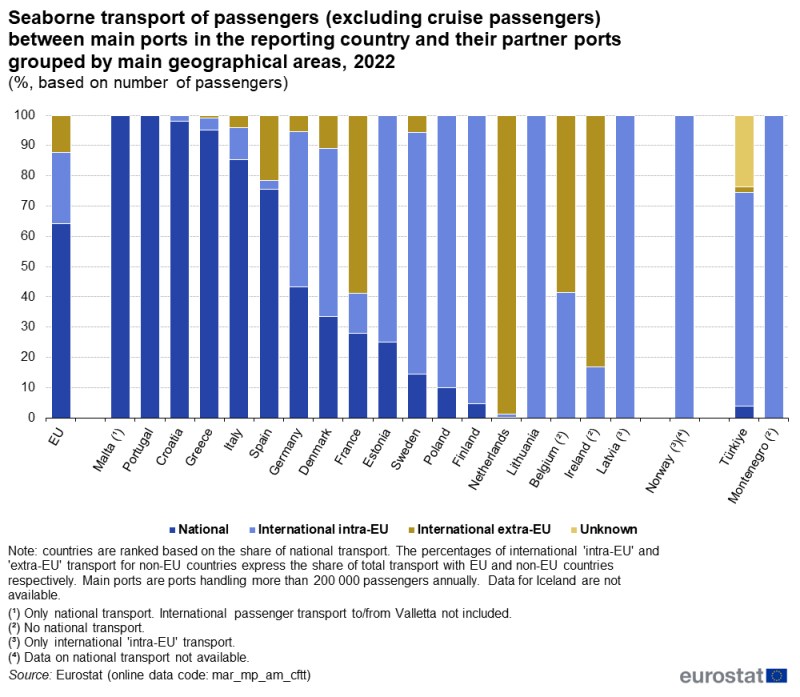
(%,based on number of passengers)
Source: Eurostat (mar_mp_am_cft)
The majority of the seaborne passenger transport (excluding cruise passengers) in the EU is carried out between ports located in the same country (64 % in 2021), reflecting the dominant role of national ferry services in the EU seaborne passenger transport (excluding cruise passengers), see Figure 4. In general, countries with busy ferry connections to and from well-populated islands will have both a large volume of seaborne passenger transport (excluding cruise passengers) and a high share of national maritime passenger transport (excluding cruise passengers). This applies to the two leading maritime passenger countries, Italy and Greece, as well as countries like Malta, Portugal, Croatia and Spain. Countries with ferry connections to other EU countries, such as Latvia, Lithuania, Finland, Poland, Sweden, Estonia, Denmark and Germany, naturally have high shares of international intra-EU transport. The Netherlands, Ireland, France and Belgium recorded the highest shares of extra-EU seaborne passenger transport (excluding cruise passengers) in 2022, having ferry links with the United Kingdom.
Source data for tables and graphs
Data sources
This article presents the trends in freight transport and vessel traffic in European Union (EU) ports and also includes figures for Iceland, Norway, Montenegro and Türkiye. The content is based on data collected within the legal framework for EU maritime transport statistics, i.e. Directive 2009/42/EC of the European Parliament and of the Council of 6 May 2009 on statistical returns in respect of carriage of goods and passengers by sea and later amendments. Directive 2009/42/EC is a recast of the original Council Directive 95/64/EC of 8 December 1995.
The EU aggregates in the statistics refer to the total of 22 maritime Member States. Czechia, Luxembourg, Hungary, Austria and Slovakia have no maritime ports. Norway and Iceland provide Eurostat with data as members of the European Economic Area (EEA). The EEA country Liechtenstein has no maritime ports. Montenegro and Türkiye provide data as candidate countries.
'Main ports' are ports handling more than 200 000 passengers annually (however, data for some smaller ports may be included in the published results). Data are presented at the level of 'statistical ports'. A statistical port consists of one or more ports, normally controlled by a single port authority, able to record ship and cargo movements.
Explanatory notes
Please note that data can be subject to revision and latest data are available in Eurostat's online database.
Basic results and derived indicators (such as growth rates and shares in % of total) in the tables are rounded. However, the figures are based on the non-rounded original data. As a result, the sum of shares in % of total, as shown in the tables, is not necessarily equal to 100 %.
Explanatory notes for countries are available in the metadata on the Eurostat website.
Starting from 2011, the figures for Spain include data for a number of minor regional ports outside the state-controlled port system. In 2020, data coverage of passengers for Portugal improved. Montenegro started to report data on seaborne transport in 2012. Data have been partially estimated by Eurostat for a number of French ports for the period 2009-2016. Detailed data on main ports are not available for Iceland.
Figures 1, 2 and 3: Data include (cruise and non-cruise) passengers starting and ending a voyage. Cruise passengers on excursion in ports (cruise transit) are excluded. Starting from 2011, the figures for Spain include data for a number of minor regional ports outside the state-controlled port system. Starting from 2018, the figures for Spain include data for a number ports that were not reported in the previous years. The Netherlands only provides the number of non-cruise passengers ('ferry passengers'). The passenger figures for Portugal do not include cruise passengers until 2011. Passenger data for Norway cover international traffic only.
Table 1: Cruise passengers on excursion in ports (cruise transit) are not included.
Table 2 and Figure 4: In order to estimate maritime transport of passengers between ports, the issue of 'double counting' (the transport of the same passengers being declared by both the port of embarkation (as outward movements) and the port of disembarkation (as inward movements) has to be addressed. Generally, when both the port of embarkation and the port of disembarkation are situated within the same statistical aggregate, only the incoming flows of passengers declared by ports are summed up to determine the total maritime transport within the aggregate ('elimination of double counting'). The algorithm for the elimination of double counting is applied at statistical port level. Thus, the total maritime transport per country excludes the double counting of maritime transport within the country. Similarly, the total maritime transport for the EU excludes the double counting of national and international intra-EU maritime transport (see metadata on the Eurostat website for more information). Starting from 2018, the figures for Spain include data for a number ports that were not reported in the previous years. Passenger transport data for Malta do not include international transport to/from the port of Valletta. Passenger data for Norway cover international traffic only. Data are not available for Iceland.
Please note that the recording of unknown port of loading or unloading may have influenced the transport figure calculations, as well as the shares of maritime transport allocated to intra-EU, extra-EU and national maritime transport.
Special symbols used in the tables
':' not available
'-' not applicable
Context
The content of this statistical article is based on data collected within the framework of the EU maritime transport statistics Directive, i.e. Directive 2009/42/EC of the European Parliament and of the Council of 6 May 2009 on statistical returns in respect of carriage of goods and passengers by sea (OJ L141 of 6.6.2009, page 29), which is a recast of the original Council Directive 95/64 (EC) of 8 December 1995.
The basic legal act (Directive 2009/42/EC) was amended by:
- Commission Decision 2010/216/EC of the European Parliament and of the Council of 14 April 2010, OJ L 94, 15.4.2010, p. 33-40
- Regulation (EU) No 1090/2010 of the European Parliament and of the Council of 24 November 2010, OJ L 325, 9.12.2010, p. 1-3
- Commission Delegated Decision 2012/186/EU of 3 February 2012 OJ L 101 of 11.4.2012 pp. 5-14.
The following legal acts include respectively the last official version of the list of ports and some dissemination aspects:
- Commission Decision 2001/423/EC of 22 May 2001 (on dissemination) OJ L 151 of 07.06.2001 p. 41
- Commission Delegated Decision (EU) 2018/1007 of 25 April 2018 supplementing Directive 2009/42/EC of the European Parliament and of the Council as regards the list of ports and repealing Commission Decision 2008/861/EC (Text with EEA relevance.) OJ L 180, 17.7.2018, p. 29–71
Direct access to
- Transport, see:
- Maritime transport (mar)
- Maritime transport - main annual results (mar_m)
- Maritime transport - short sea shipping - main annual results (mar_s)
- Maritime transport - passengers (mar_pa)
- Maritime transport - goods (mar_go)
- Maritime transport - vessel traffic (mar_tf)
- Maritime transport - regional statistics (mar_rg)
- Maritime transport (ESMS metadata file — mar_esms)
- Reference Manual on Maritime Transport Statistics
- Glossary for transport statistics - 5th edition - 2019